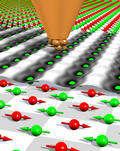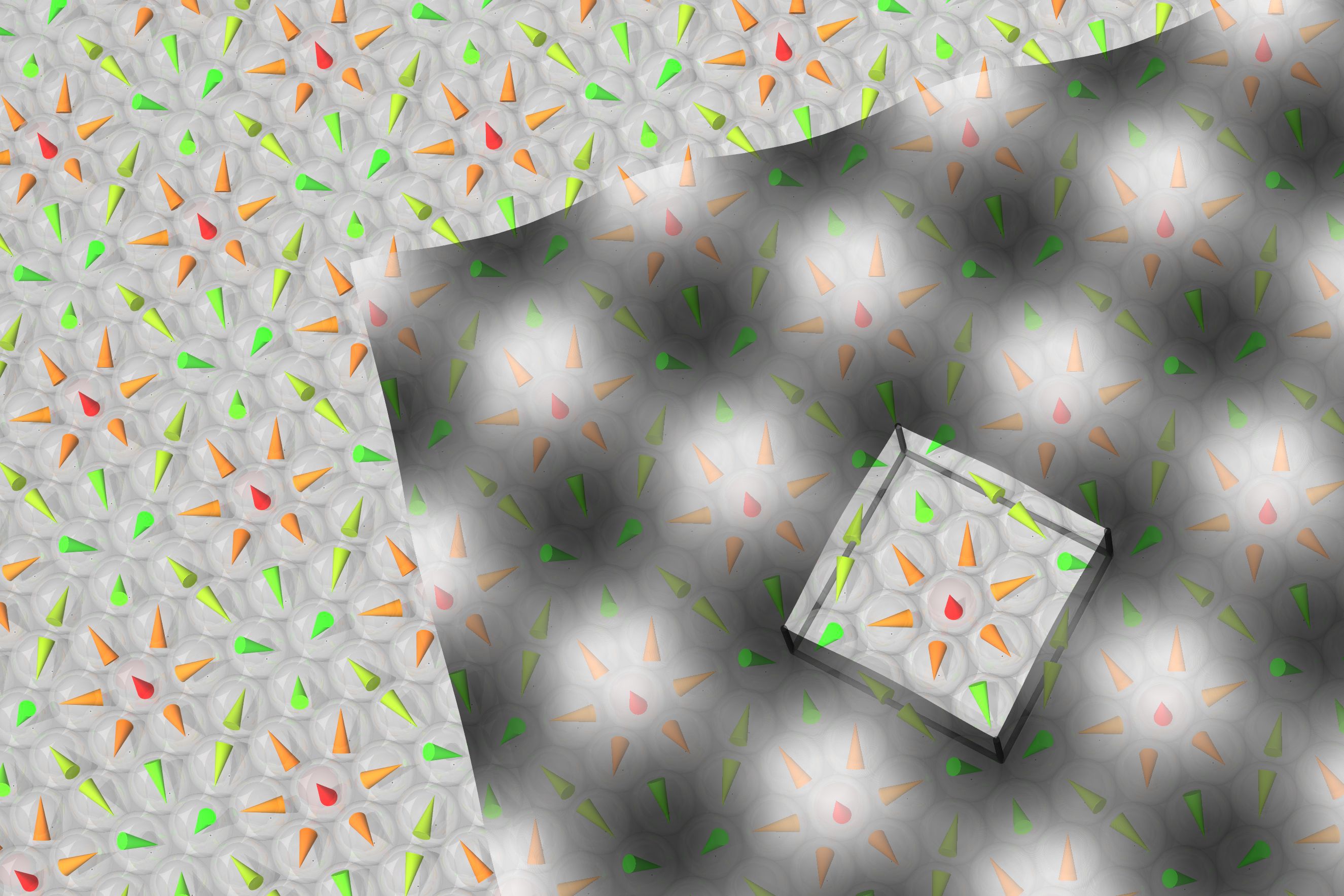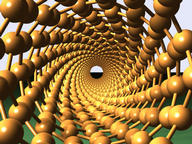Research Activities
We explore novel materials for future applications in nano- and spinelectronic devices, quantum computation,
or neuromorphic computing using powerful
methods of theoretical solid state physics involving computations on large computer clusters and/or
supercomputers. We can calculate the properties of real nanostructures such as their electronic and
magnetic structure from first-principles, i.e. free of any empirical input parameters. This enables us
not only to interpret and explain unexpected experiments but to predict the properties of new materials
and help to guide experimental efforts at the institute and of our national and international collaborators.
In particular the interpretation of experiments
using scanning probe methods can be non-trivial and the combination with first-principles calculations
can be very valuable.
For many technological applications the transport properties of nanostructures are crucial. However, due
to their reduced dimensionality nanoscale devices such as carbon nanotube transistors behave quite
differently from conventional silicon transistors. We explore the transport in nanostructures using
semiclassical and quantum-mechanical models. Due to the huge number of atoms involved in a real device
the electronic structure is treated with semi-empirical methods. In the future, we strive for a
combination of the transport calculations with a first-principles description of the electronic
properties.
Magnetism of nanostructures
 Today, accurate first-principles (parameter-free) calculations of the electronic structure are
feasible for a wide class of materials and structures. Using large-scale computer clusters or
supercomputers we can study the structural, electronic, chemical, and magnetic properties of real
nanostructures e.g. molecules or atomic chains on surfaces. The properties of novel materials can be explained and even be predicted. In the past
this has often triggered experimental work. We are also concerned with the theory of scanning probe
methods such as
spin-polarized scanning tunneling microscopy
or magnetic exchange force microscopy which
allow to reveal magnetic structures down to the atomic scale. These tools have boosted nanoscience, however, the
interpretation of experiments is often difficult. In combination with first-principles calculations
many unexpected effects have been clarified.
Today, accurate first-principles (parameter-free) calculations of the electronic structure are
feasible for a wide class of materials and structures. Using large-scale computer clusters or
supercomputers we can study the structural, electronic, chemical, and magnetic properties of real
nanostructures e.g. molecules or atomic chains on surfaces. The properties of novel materials can be explained and even be predicted. In the past
this has often triggered experimental work. We are also concerned with the theory of scanning probe
methods such as
spin-polarized scanning tunneling microscopy
or magnetic exchange force microscopy which
allow to reveal magnetic structures down to the atomic scale. These tools have boosted nanoscience, however, the
interpretation of experiments is often difficult. In combination with first-principles calculations
many unexpected effects have been clarified.
Read more about current projects in "Magnetism of Nanostructures".
Topological spin structures
 Since the discovery of magnetic skyrmions - stable, localized magnetic whirls - the research on topological spin structures has rapidly increased and has become a major topic in condensed-matter physics
with many potential applications (cf. „The 2020 Skyrmionics Roadmap“, C. Back et al, J. Phys. D: Appl. Phys. (2020)).
In collaboration with the experimental research group of Prof. Wiesendanger (University of Hamburg) and colleagues from the Forschungszentrum Jülich
we revealed
skyrmions in ultrathin magnetic films at surfaces
(Nature Phys. 7,
713 (2011)).
This discovery opened a new class of materials for skyrmions: transition-metal interfaces. Such interfaces occur in all magnetic multilayers which are already being used today in spintronic devices such as
readheads of hard disks or magnetic sensors and thus provide a link to current technology. Besides the application of skyrmions in race-track memory devices or logic gates these topological spin structures
hold great promise in neuromorphic computing. At hybrid magnetic-superconductor interfaces skyrmions can induce Majorana fermions which may be used in topological quantum computers.
Since the discovery of magnetic skyrmions - stable, localized magnetic whirls - the research on topological spin structures has rapidly increased and has become a major topic in condensed-matter physics
with many potential applications (cf. „The 2020 Skyrmionics Roadmap“, C. Back et al, J. Phys. D: Appl. Phys. (2020)).
In collaboration with the experimental research group of Prof. Wiesendanger (University of Hamburg) and colleagues from the Forschungszentrum Jülich
we revealed
skyrmions in ultrathin magnetic films at surfaces
(Nature Phys. 7,
713 (2011)).
This discovery opened a new class of materials for skyrmions: transition-metal interfaces. Such interfaces occur in all magnetic multilayers which are already being used today in spintronic devices such as
readheads of hard disks or magnetic sensors and thus provide a link to current technology. Besides the application of skyrmions in race-track memory devices or logic gates these topological spin structures
hold great promise in neuromorphic computing. At hybrid magnetic-superconductor interfaces skyrmions can induce Majorana fermions which may be used in topological quantum computers.
Read more about current projects in "Topological spin structures".
Quantum Transport
 In the past four decades, down-scaling the size of silicon devices to characteristic lengths below
100 nanometers has led to an unprecedented enhancement of computer performance allowing today's
information technology. However, further shrinking of the structures may be limited by effects such
as leakage currents and increasing power consumption. In addition, quantum effects become important
on the nanometer scale. New materials such as nanotubes and nanowires are being intensively explored
today by both industrial and academic research. For example, carbon nanotubes have raised high hopes
due to their unique combination of structural and electronic properties such as ballistic
transport. We explore the transport in nanoelectronic devices using semiclassical and
quantum-mechanical models. Another field of interest is the transport of single-atom or molecule junctions.
Novel effects such as
the ballistic or the tunneling anisotropic magnetoresistance (AMR) have been discovered and are explored
in collaboration with experimental partners.
In the past four decades, down-scaling the size of silicon devices to characteristic lengths below
100 nanometers has led to an unprecedented enhancement of computer performance allowing today's
information technology. However, further shrinking of the structures may be limited by effects such
as leakage currents and increasing power consumption. In addition, quantum effects become important
on the nanometer scale. New materials such as nanotubes and nanowires are being intensively explored
today by both industrial and academic research. For example, carbon nanotubes have raised high hopes
due to their unique combination of structural and electronic properties such as ballistic
transport. We explore the transport in nanoelectronic devices using semiclassical and
quantum-mechanical models. Another field of interest is the transport of single-atom or molecule junctions.
Novel effects such as
the ballistic or the tunneling anisotropic magnetoresistance (AMR) have been discovered and are explored
in collaboration with experimental partners.
Read more about current projects in "Quantum Transport".
 Today, accurate first-principles (parameter-free) calculations of the electronic structure are
feasible for a wide class of materials and structures. Using large-scale computer clusters or
supercomputers we can study the structural, electronic, chemical, and magnetic properties of real
nanostructures e.g. molecules or atomic chains on surfaces. The properties of novel materials can be explained and even be predicted. In the past
this has often triggered experimental work. We are also concerned with the theory of scanning probe
methods such as
spin-polarized scanning tunneling microscopy
or magnetic exchange force microscopy which
allow to reveal magnetic structures down to the atomic scale. These tools have boosted nanoscience, however, the
interpretation of experiments is often difficult. In combination with first-principles calculations
many unexpected effects have been clarified.
Today, accurate first-principles (parameter-free) calculations of the electronic structure are
feasible for a wide class of materials and structures. Using large-scale computer clusters or
supercomputers we can study the structural, electronic, chemical, and magnetic properties of real
nanostructures e.g. molecules or atomic chains on surfaces. The properties of novel materials can be explained and even be predicted. In the past
this has often triggered experimental work. We are also concerned with the theory of scanning probe
methods such as
spin-polarized scanning tunneling microscopy
or magnetic exchange force microscopy which
allow to reveal magnetic structures down to the atomic scale. These tools have boosted nanoscience, however, the
interpretation of experiments is often difficult. In combination with first-principles calculations
many unexpected effects have been clarified.
 Since the discovery of magnetic skyrmions - stable, localized magnetic whirls - the research on topological spin structures has rapidly increased and has become a major topic in condensed-matter physics
with many potential applications (cf. „The 2020 Skyrmionics Roadmap“, C. Back et al, J. Phys. D: Appl. Phys. (2020)).
In collaboration with the experimental research group of Prof. Wiesendanger (University of Hamburg) and colleagues from the Forschungszentrum Jülich
we revealed
skyrmions in ultrathin magnetic films at surfaces
(Nature Phys. 7,
713 (2011)).
This discovery opened a new class of materials for skyrmions: transition-metal interfaces. Such interfaces occur in all magnetic multilayers which are already being used today in spintronic devices such as
readheads of hard disks or magnetic sensors and thus provide a link to current technology. Besides the application of skyrmions in race-track memory devices or logic gates these topological spin structures
hold great promise in neuromorphic computing. At hybrid magnetic-superconductor interfaces skyrmions can induce Majorana fermions which may be used in topological quantum computers.
Since the discovery of magnetic skyrmions - stable, localized magnetic whirls - the research on topological spin structures has rapidly increased and has become a major topic in condensed-matter physics
with many potential applications (cf. „The 2020 Skyrmionics Roadmap“, C. Back et al, J. Phys. D: Appl. Phys. (2020)).
In collaboration with the experimental research group of Prof. Wiesendanger (University of Hamburg) and colleagues from the Forschungszentrum Jülich
we revealed
skyrmions in ultrathin magnetic films at surfaces
(Nature Phys. 7,
713 (2011)).
This discovery opened a new class of materials for skyrmions: transition-metal interfaces. Such interfaces occur in all magnetic multilayers which are already being used today in spintronic devices such as
readheads of hard disks or magnetic sensors and thus provide a link to current technology. Besides the application of skyrmions in race-track memory devices or logic gates these topological spin structures
hold great promise in neuromorphic computing. At hybrid magnetic-superconductor interfaces skyrmions can induce Majorana fermions which may be used in topological quantum computers.
 In the past four decades, down-scaling the size of silicon devices to characteristic lengths below
100 nanometers has led to an unprecedented enhancement of computer performance allowing today's
information technology. However, further shrinking of the structures may be limited by effects such
as leakage currents and increasing power consumption. In addition, quantum effects become important
on the nanometer scale. New materials such as nanotubes and nanowires are being intensively explored
today by both industrial and academic research. For example, carbon nanotubes have raised high hopes
due to their unique combination of structural and electronic properties such as ballistic
transport. We explore the transport in nanoelectronic devices using semiclassical and
quantum-mechanical models. Another field of interest is the transport of single-atom or molecule junctions.
Novel effects such as
the ballistic or the tunneling anisotropic magnetoresistance (AMR) have been discovered and are explored
in collaboration with experimental partners.
In the past four decades, down-scaling the size of silicon devices to characteristic lengths below
100 nanometers has led to an unprecedented enhancement of computer performance allowing today's
information technology. However, further shrinking of the structures may be limited by effects such
as leakage currents and increasing power consumption. In addition, quantum effects become important
on the nanometer scale. New materials such as nanotubes and nanowires are being intensively explored
today by both industrial and academic research. For example, carbon nanotubes have raised high hopes
due to their unique combination of structural and electronic properties such as ballistic
transport. We explore the transport in nanoelectronic devices using semiclassical and
quantum-mechanical models. Another field of interest is the transport of single-atom or molecule junctions.
Novel effects such as
the ballistic or the tunneling anisotropic magnetoresistance (AMR) have been discovered and are explored
in collaboration with experimental partners.